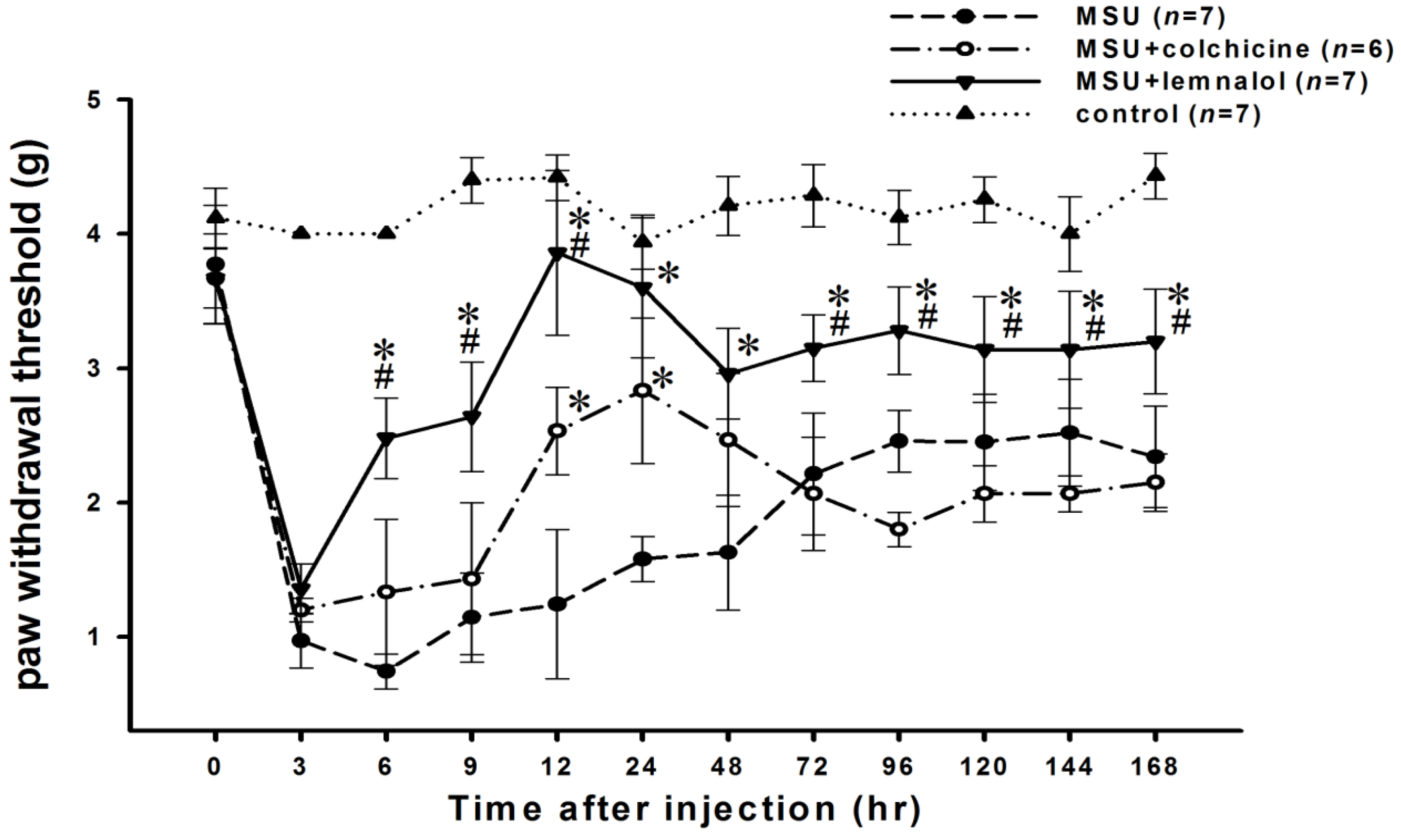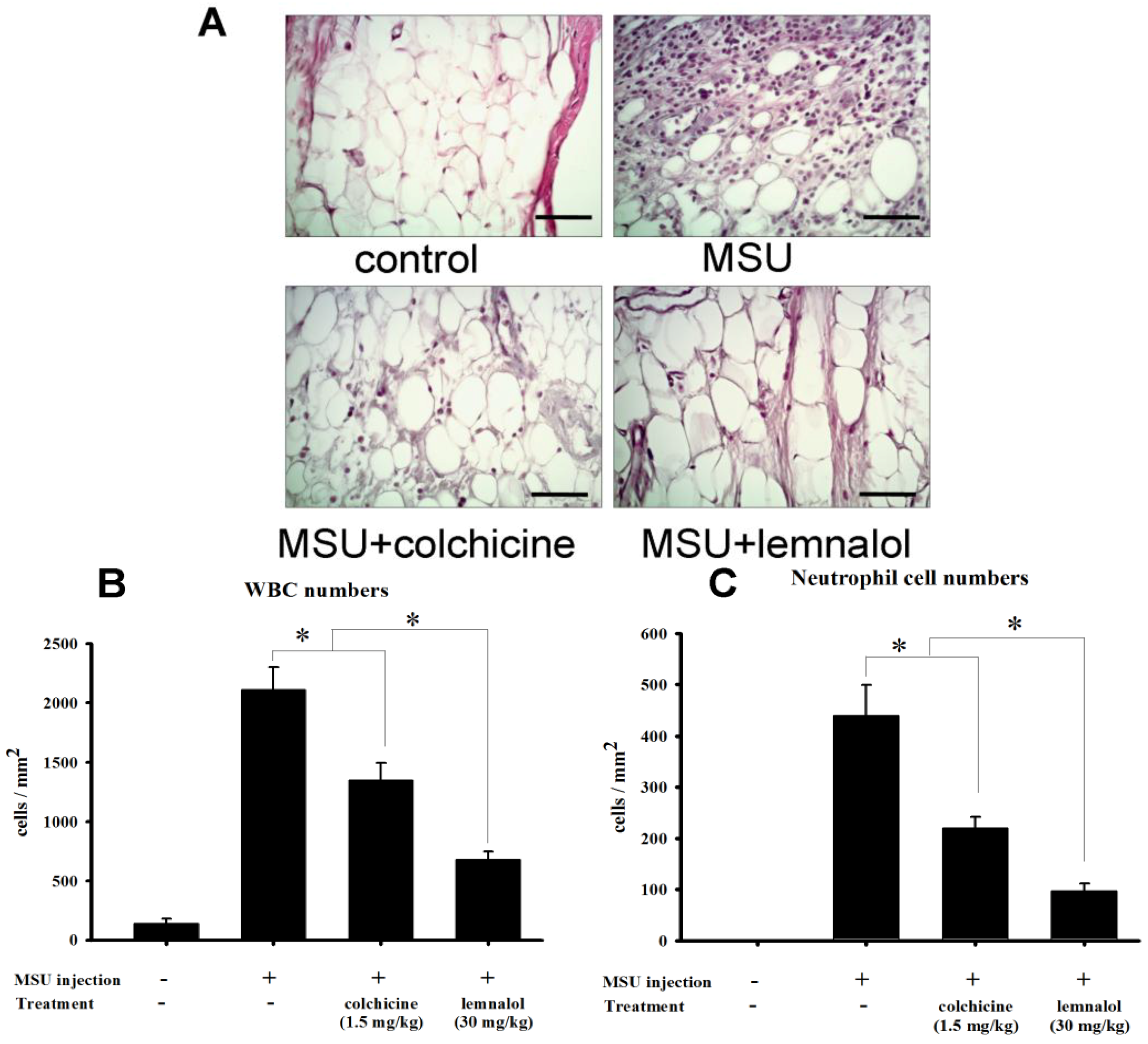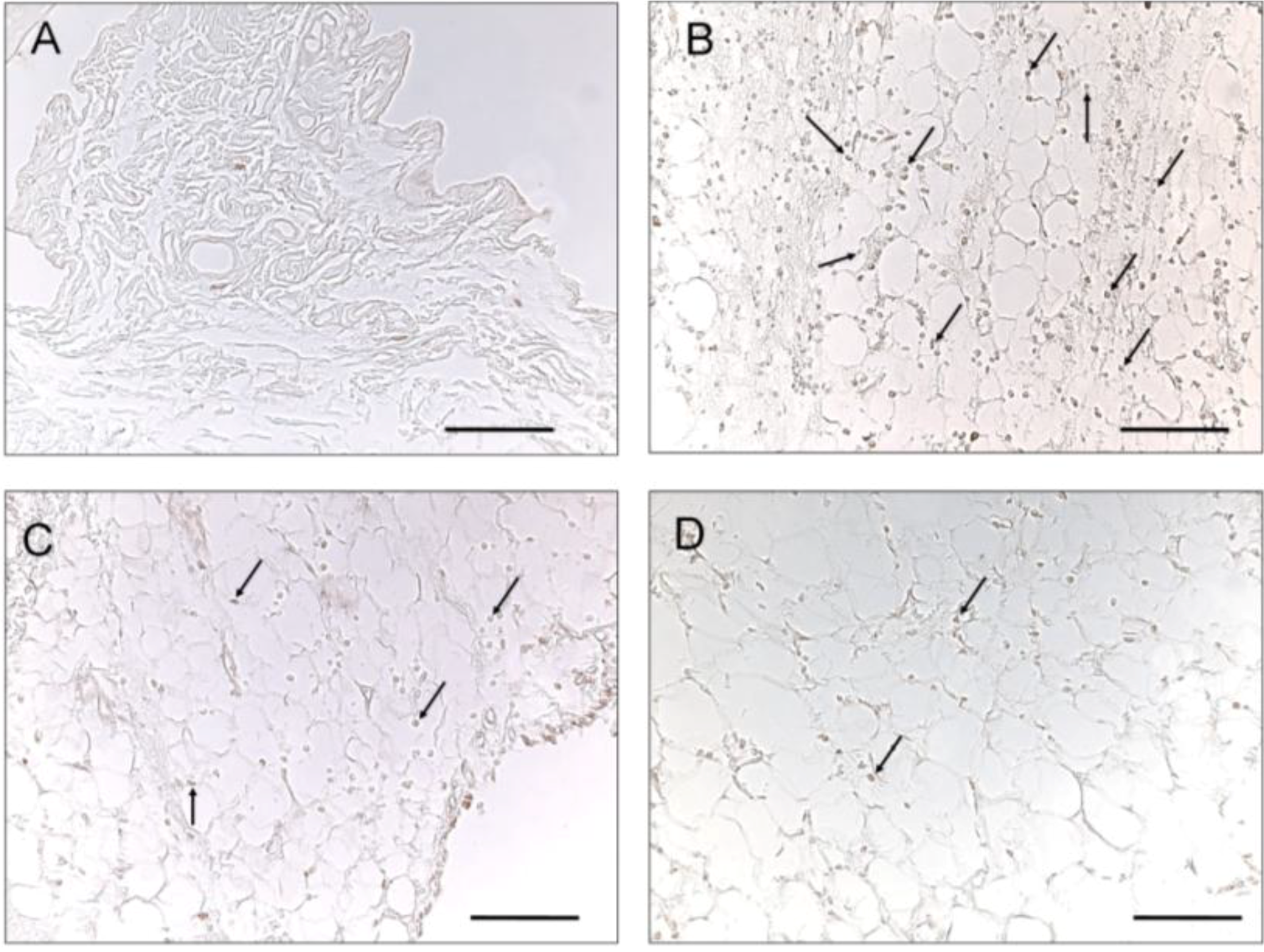Soft Coral-Derived Lemnalol Alleviates Monosodium Urate-Induced Gouty Arthritis in Rats by Inhibiting Leukocyte Infiltration and iNOS, COX-2 and c-Fos Protein Expression
Abstract
:1. Introduction
2. Results
2.1. The Effects of Lemnalol on the Inflammation Induced by MSU


2.2. Histomorphometric Analysis of the Effect of Lemnalol on MSU-Induced Infiltration

2.3. Effects of Lemnalol on iNOS, COX-2 and c-Fos Protein Expression in Ankle Synovium


3. Discussion
3.1. Lemnalol Attenuates MSU-Induced Inflammation
3.2. Effects of Lemnalol on iNOS and COX-2 in MSU-Induced Gouty Arthritis
3.3. The Effect of Lemnalol on c-Fos in MSU-Induced Gouty Arthritis
3.4. Colchicine and Lemnalol Dosages in the Present Study
3.5. Summary
4. Material and Methods
4.1. Animals
4.2. MSU Preparation and the Gout Animal Model
4.3. Experimental Design
4.4. Measurement of Nociceptive Behavior (Mechanical Allodynia)
4.5. Measurement of Knee Width and Ankle Edema
4.6. Histopathological Examination
4.7. Immunohistochemistry for iNOS, COX-2 and c-Fos
4.8. Statistical Analysis
5. Conclusions
Acknowledgments
References
- Neogi, T. Clinical practice. Gout. N. Engl. J. Med. 2011, 364, 443–452. [Google Scholar] [CrossRef]
- Coderre, T.J.; Wall, P.D. Ankle joint urate arthritis (AJUA) in rats: An alternative animal model of arthritis to that produced by Freund’s adjuvant. Pain 1987, 28, 379–393. [Google Scholar] [CrossRef]
- Nishimura, A.; Akahoshi, T.; Takahashi, M.; Takagishi, K.; Itoman, M.; Kondo, H.; Takahashi, Y.; Yokoi, K.; Mukaida, N.; Matsushima, K. Attenuation of monosodium urate crystal-induced arthritis in rabbits by a neutralizing antibody against interleukin-8. J. Leukoc. Biol. 1997, 62, 444–449. [Google Scholar]
- Getting, S.J.; Christian, H.C.; Flower, R.J.; Perretti, M. Activation of melanocortin type 3 receptor as a molecular mechanism for adrenocorticotropic hormone efficacy in gouty arthritis. Arthritis Rheum. 2002, 46, 2765–2775. [Google Scholar] [CrossRef]
- Martin, W.J.; Herst, P.M.; Chia, E.W.; Harper, J.L. Sesquiterpene dialdehydes inhibit MSU crystal-induced superoxide production by infiltrating neutrophils in an in vivo model of gouty inflammation. Free Radic. Biol. Med. 2009, 47, 616–621. [Google Scholar] [CrossRef]
- Terkeltaub, R.A.; Ginsberg, M.H. The inflammatory reaction to crystals. Rheum. Dis. Clin. North. Am. 1988, 14, 353–364. [Google Scholar]
- Chen, L.; Hsieh, M.S.; Ho, H.C.; Liu, Y.H.; Chou, D.T.; Tsai, S.H. Stimulation of inducible nitric oxide synthase by monosodium urate crystals in macrophages and expression of iNOS in gouty arthritis. Nitric Oxide 2004, 11, 228–236. [Google Scholar] [CrossRef]
- Miyasaka, N.; Hirata, Y. Nitric oxide and inflammatory arthritides. Life Sci. 1997, 61, 2073–2081. [Google Scholar] [CrossRef]
- Trabandt, A.; Gay, R.E.; Birkedal-Hansen, H.; Gay, S. Expression of collagenase and potential transcriptional factors in the MRL/l mouse arthropathy. Semin. Arthritis Rheum. 1992, 21, 246–251. [Google Scholar] [CrossRef]
- Woolf, A.D.; Dieppe, P.A. Mediators of crystal-induced inflammation in the joint. Br. Med. Bull. 1987, 43, 429–444. [Google Scholar]
- Suput, D. In vivo effects of cnidarian toxins and venoms. Toxicon 2009, 54, 1190–1200. [Google Scholar] [CrossRef]
- Blunt, J.W.; Copp, B.R.; Keyzers, R.A.; Munro, M.H.; Prinsep, M.R. Marine natural products. Nat. Prod. Rep. 2012, 29, 144–222. [Google Scholar]
- Jean, Y.H.; Chen, W.F.; Duh, C.Y.; Huang, S.Y.; Hsu, C.H.; Lin, C.S.; Sung, C.S.; Chen, I.M.; Wen, Z.H. Inducible nitric oxide synthase and cyclooxygenase-2 participate in anti-inflammatory and analgesic effects of the natural marine compound lemnalol from Formosan soft coral Lemnalia cervicorni. Eur. J. Pharmacol. 2008, 578, 323–331. [Google Scholar] [CrossRef]
- Kikuchi, H.; Manda, T.; Kobayashi, K.; Yamada, Y.; Iguchi, K. Antitumor activity of lemnalol isolated from the soft coral Lemnalia tenuis Verseveldt. Chem. Pharm. Bull. 1983, 31, 1086–1088. [Google Scholar]
- Lin, Y.C.; Huang, S.Y.; Jean, Y.H.; Chen, W.F.; Sung, C.S.; Kao, E.S.; Wang, H.M.; Chakraborty, C.; Duh, C.Y.; Wen, Z.H. Intrathecal lemnalol, a natural marine compound obtained from Formosan soft coral, attenuates nociceptive responses and the activity of spinal glial cells in neuropathic rats. Behav. Pharmacol. 2011, 22, 739–750. [Google Scholar] [CrossRef]
- Okuda, K.; Nakahama, H.; Miyakawa, H.; Shima, K. Arthritis induced in cat by sodium urate: A possible animal model for tonic pain. Pain 1984, 18, 287–297. [Google Scholar] [CrossRef]
- Coderre, T.J.; Wall, P.D. Ankle joint urate arthritis in rats provides a useful tool for the evaluation of analgesic and anti-arthritic agents. Pharmacol. Biochem. Behav. 1988, 29, 461–466. [Google Scholar] [CrossRef]
- Miguelez, R.; Palacios, I.; Navarro, F.; Gutierrez, S.; Sanchez-Pernaute, O.; Egido, J.; Gonzalez, E.; Herrero-Beaumont, G. Anti-inflammatory effect of a PAF receptor antagonist and a new molecule with antiproteinase activity in an experimental model of acute urate crystal arthritis. J. Lipid Mediat. Cell Signal. 1996, 13, 35–49. [Google Scholar] [CrossRef]
- Hoffmeister, C.; Trevisan, G.; Rossato, M.F.; de Oliveira, S.M.; Gomez, M.V.; Ferreira, J. Role of TRPV1 in nociception and edema induced by monosodium urate crystals in rats. Pain 2011, 152, 1777–1788. [Google Scholar]
- Busso, N.; So, A. Mechanisms of inflammation in gout. Arthritis Res. Ther. 2010, 12, 206. [Google Scholar] [CrossRef]
- Dalbeth, N.; Haskard, D.O. Mechanisms of inflammation in gout. Rheumatology 2005, 44, 1090–1096. [Google Scholar] [CrossRef]
- Funez, M.I.; Ferrari, L.F.; Duarte, D.B.; Sachs, D.; Cunha, F.Q.; Lorenzetti, B.B.; Parada, C.A.; Ferreira, S.H. Teleantagonism: A pharmacodynamic property of the primary nociceptive neuron. Proc. Natl. Acad. Sci. USA 2008, 105, 19038–19043. [Google Scholar]
- Pouliot, M.; James, M.J.; McColl, S.R.; Naccache, P.H.; Cleland, L.G. Monosodium urate microcrystals induce cyclooxygenase-2 in human monocytes. Blood 1998, 91, 1769–1776. [Google Scholar]
- Kang, D.H.; Nakagawa, T.; Feng, L.; Watanabe, S.; Han, L.; Mazzali, M.; Truong, L.; Harris, R.; Johnson, R.J. A role for uric acid in the progression of renal disease. J. Am. Soc. Nephrol. 2002, 13, 2888–2897. [Google Scholar] [CrossRef]
- Lee, H.S.; Lee, C.H.; Tsai, H.C.; Salter, D.M. Inhibition of cyclooxygenase 2 expression by diallyl sulfide on joint inflammation induced by urate crystal and IL-1β. Osteoarthr. Cartil. 2009, 17, 91–99. [Google Scholar] [CrossRef]
- Lowenstein, C.J.; Padalko, E. iNOS (NOS2) at a glance. J. Cell Sci. 2004, 117, 2865–2867. [Google Scholar] [CrossRef]
- Farrell, A.J.; Blake, D.R.; Palmer, R.M.; Moncada, S. Increased concentrations of nitrite in synovial fluid and serum samples suggest increased nitric oxide synthesis in rheumatic diseases. Ann. Rheum. Dis. 1992, 51, 1219–1222. [Google Scholar] [CrossRef]
- St. Clair, E.W.; Wilkinson, W.E.; Lang, T.; Sanders, L.; Misukonis, M.A.; Gilkeson, G.S.; Pisetsky, D.S.; Granger, D.I.; Weinberg, J.B. Increased expression of blood mononuclear cell nitric oxide synthase type 2 in rheumatoid arthritis patients. J. Exp. Med. 1996, 184, 1173–1178. [Google Scholar] [CrossRef]
- Eferl, R.; Wagner, E.F. AP-1: A double-edged sword in tumorigenesis. Nat. Rev. Cancer 2003, 3, 859–868. [Google Scholar] [CrossRef]
- Trabandt, A.; Aicher, W.K.; Gay, R.E.; Sukhatme, V.P.; Fassbender, H.G.; Gay, S. Spontaneous expression of immediately-early response genes c-fos and egr-1 in collagenase-producing rheumatoid synovial fibroblasts. Rheum. Int. 1992, 12, 53–59. [Google Scholar] [CrossRef]
- Cheung, H.S. Crystal/cell interactions in osteoarthritis. Curr. Opin. Orthop. 2006, 17, 424–428. [Google Scholar] [CrossRef]
- McCarthy, G.M.; Augustine, J.A.; Baldwin, A.S.; Christopherson, P.A.; Cheung, H.S.; Westfall, P.R.; Scheinman, R.I. Molecular mechanism of basic calcium phosphate crystal-induced activation of human fibroblasts—Role of nuclear factor κB, activator protein 1 and protein kinase C. J. Biol. Chem. 1998, 273, 35161–35169. [Google Scholar]
- Chu, S.C.; Yang, S.F.; Lue, K.H.; Hsieh, Y.S.; Hsiao, T.Y.; Lu, K.H. The clinical significance of gelatinase B in gouty arthritis of the knee. Clin. Chim. Acta 2004, 339, 77–83. [Google Scholar] [CrossRef]
- Aikawa, Y.; Morimoto, K.; Yamamoto, T.; Chaki, H.; Hashiramoto, A.; Narita, H.; Hirono, S.; Shiozawa, S. Treatment of arthritis with a selective inhibitor of c-Fos/activator protein-1. Nat. Biotechnol. 2008, 26, 817–823. [Google Scholar] [CrossRef]
- Shiozawa, S.; Shimizu, K.; Tanaka, K.; Hino, K. Studies on the contribution of c-fos/AP-1 to arthritic joint destruction. J. Clin. Invest. 1997, 99, 1210–1216. [Google Scholar] [CrossRef]
- Schonthal, A.; Herrlich, P.; Rahmsdorf, H.J.; Ponta, H. Requirement for fos gene expression in the transcriptional activation of collagenase by other oncogenes and phorbol esters. Cell 1988, 54, 325–334. [Google Scholar] [CrossRef]
- Closs, E.I.; Murray, A.B.; Schmidt, J.; Schon, A.; Erfle, V.; Strauss, P.G. c-fos expression precedes osteogenic differentiation of cartilage cells in vitro. J. Cell Biol. 1990, 111, 1313–1323. [Google Scholar] [CrossRef]
- U.S. Department of Health and Human ServicesFood and Drug Administration (FDA)Center for Drug Evaluation and Research (CDER)Guidance for Industry: Estimating the Maximum Safe Starting Dose in Initial Clinical Trials for Therapeutics in Adult Healthy Volunteers; FDA: Rockville, MD, USA, 2005; pp. 6–8.
- Cocco, G.; Chu, D.C.; Pandolfi, S. Colchicine in clinical medicine. A guide for internists. Eur. J. Intern. Med. 2010, 21, 503–508. [Google Scholar] [CrossRef]
- Zweig, M.H.; Maling, H.M.; Webster, M.E. Inhibition of sodium urate-induced rat hindpaw edema by colchicine derivatives: Correlation with antimitotic activity. J. Pharmacol. Exp. Ther. 1972, 182, 344–350. [Google Scholar]
- Malcolm Rowland, T.N.T. Clinical Pharmacokinetics and Pharmacodynamics, 4th ed; Lippincott Williams & Wilkins: Philadelphia, PA, USA, 1995; pp. 687–690. [Google Scholar]
- Chaplan, S.R.; Bach, F.W.; Pogrel, J.W.; Chung, J.M.; Yaksh, T.L. Quantitative assessment of tactile allodynia in the rat paw. J. Neurosci. Methods 1994, 53, 55–63. [Google Scholar] [CrossRef]
- Niki, Y.; Yamada, H.; Seki, S.; Kikuchi, T.; Takaishi, H.; Toyama, Y.; Fujikawa, K.; Tada, N. Macrophage- and neutrophil-dominant arthritis in human IL-1α transgenic mice. J. Clin. Investig. 2001, 107, 1127–1135. [Google Scholar] [CrossRef]
- Ross, M.H.; Pawlina, W. Histology: A Text and Atlas with Correlated Cell and Molecular Biology, 5th ed; Lippincott Williams & Wilkins: Philadelphia, PA, USA, 2005; pp. 146–181. [Google Scholar]
- Fujita, K.; Akasaka, Y.; Kuwabara, T.; Wang, B.; Tanaka, K.; Kamata, I.; Yokoo, T.; Kinoshita, T.; Iuchi, A.; Akishima-Fukasawa, Y.; et al. Pathogenesis of lupus-like nephritis through autoimmune antibody produced by CD180-negative B lymphocytes in NZBWF1 mouse. Immunol. Lett. 2012, 144, 1–6. [Google Scholar] [CrossRef]
© 2013 by the authors; licensee MDPI, Basel, Switzerland. This article is an open-access article distributed under the terms and conditions of the Creative Commons Attribution license (http://creativecommons.org/licenses/by/3.0/).
Share and Cite
Lee, H.-P.; Huang, S.-Y.; Lin, Y.-Y.; Wang, H.-M.; Jean, Y.-H.; Wu, S.-F.; Duh, C.-Y.; Wen, Z.-H. Soft Coral-Derived Lemnalol Alleviates Monosodium Urate-Induced Gouty Arthritis in Rats by Inhibiting Leukocyte Infiltration and iNOS, COX-2 and c-Fos Protein Expression. Mar. Drugs 2013, 11, 99-113. https://doi.org/10.3390/md11010099
Lee H-P, Huang S-Y, Lin Y-Y, Wang H-M, Jean Y-H, Wu S-F, Duh C-Y, Wen Z-H. Soft Coral-Derived Lemnalol Alleviates Monosodium Urate-Induced Gouty Arthritis in Rats by Inhibiting Leukocyte Infiltration and iNOS, COX-2 and c-Fos Protein Expression. Marine Drugs. 2013; 11(1):99-113. https://doi.org/10.3390/md11010099
Chicago/Turabian StyleLee, Hsin-Pai, Shi-Ying Huang, Yen-You Lin, Hui-Min Wang, Yen-Hsuan Jean, Shu-Fen Wu, Chang-Yih Duh, and Zhi-Hong Wen. 2013. "Soft Coral-Derived Lemnalol Alleviates Monosodium Urate-Induced Gouty Arthritis in Rats by Inhibiting Leukocyte Infiltration and iNOS, COX-2 and c-Fos Protein Expression" Marine Drugs 11, no. 1: 99-113. https://doi.org/10.3390/md11010099




